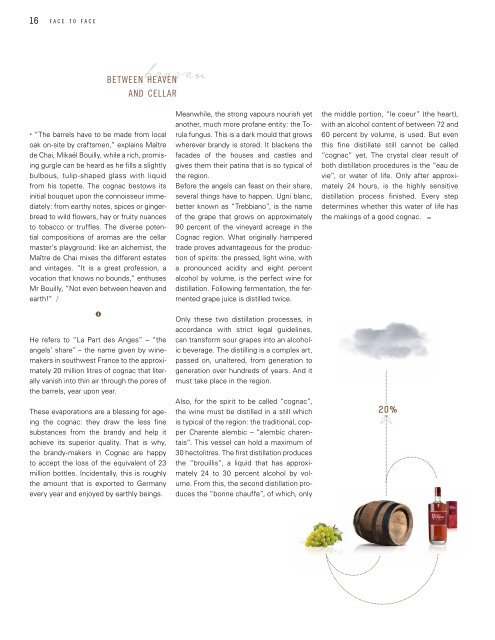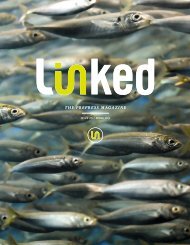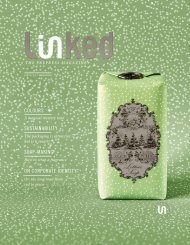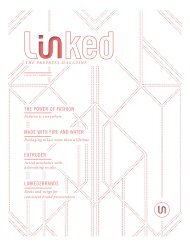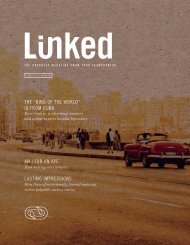Create successful ePaper yourself
Turn your PDF publications into a flip-book with our unique Google optimized e-Paper software.
16<br />
f a c e t o f a c e<br />
between heaven<br />
and cellar<br />
“The barrels have to be made from local<br />
oak on-site by craftsmen,” explains Maître<br />
de Chai, Mikaël Bouilly, while a rich, promising<br />
gurgle can be heard as he fills a slightly<br />
bulbous, tulip-shaped glass with liquid<br />
from his topette. The cognac bestows its<br />
initial bouquet upon the connoisseur immediately:<br />
from earthy notes, spices or gingerbread<br />
to wild flowers, hay or fruity nuances<br />
to tobacco or truffles. The diverse potential<br />
compositions of aromas are the cellar<br />
master’s playground: like an alchemist, the<br />
Maître de Chai mixes the different estates<br />
and vintages. “It is a great profession, a<br />
vocation that knows no bounds,” enthuses<br />
Mr Bouilly, “Not even between heaven and<br />
earth!” /<br />
Meanwhile, the strong vapours nourish yet<br />
another, much more profane entity: the Torula<br />
fungus. This is a dark mould that grows<br />
wherever brandy is stored. It blackens the<br />
facades of the houses and castles and<br />
gives them their patina that is so typical of<br />
the region.<br />
Before the angels can feast on their share,<br />
several things have to happen. Ugni blanc,<br />
better known as “Trebbiano”, is the name<br />
of the grape that grows on approximately<br />
90 percent of the vineyard acreage in the<br />
Cognac region. What originally hampered<br />
trade proves advantageous for the production<br />
of spirits: the pressed, light wine, with<br />
a pronounced acidity and eight percent<br />
alcohol by volume, is the perfect wine for<br />
distillation. Following fermentation, the fermented<br />
grape juice is distilled twice.<br />
the middle portion, “le coeur” (the heart),<br />
with an alcohol content of between 72 and<br />
60 percent by volume, is used. But even<br />
this fine distillate still cannot be called<br />
“cognac” yet. The crystal clear result of<br />
both distillation procedures is the “eau de<br />
vie”, or water of life. Only after approximately<br />
24 hours, is the highly sensitive<br />
distillation process finished. Every step<br />
determines whether this water of life has<br />
the makings of a good cognac.<br />
He refers to “La Part des Anges” – “the<br />
angels’ share” – the name given by winemakers<br />
in southwest France to the approximately<br />
20 million litres of cognac that literally<br />
vanish into thin air through the pores of<br />
the barrels, year upon year.<br />
These evaporations are a blessing for ageing<br />
the cognac: they draw the less fine<br />
substances from the brandy and help it<br />
achieve its superior quality. That is why,<br />
the brandy-makers in Cognac are happy<br />
to accept the loss of the equivalent of 23<br />
million bottles. Incidentally, this is roughly<br />
the amount that is exported to Germany<br />
every year and enjoyed by earthly beings.<br />
Only these two distillation processes, in<br />
accordance with strict legal guidelines,<br />
can transform sour grapes into an alcoholic<br />
beverage. The distilling is a complex art,<br />
passed on, unaltered, from generation to<br />
generation over hundreds of years. And it<br />
must take place in the region.<br />
Also, for the spirit to be called “cognac”,<br />
the wine must be distilled in a still which<br />
is typical of the region: the traditional, copper<br />
Charente alembic – “alembic charentais”.<br />
This vessel can hold a maximum of<br />
30 hectolitres. The first distillation produces<br />
the “brouillis”, a liquid that has approximately<br />
24 to 30 percent alcohol by volume.<br />
From this, the second distillation produces<br />
the “bonne chauffe”, of which, only<br />
20%


